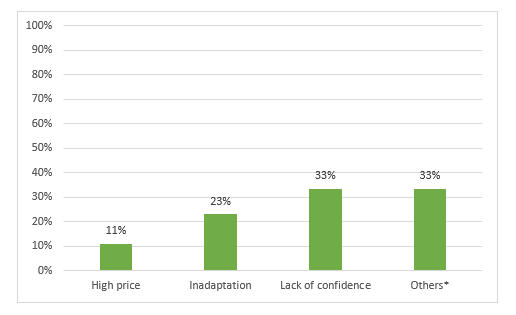Presbyopia is the gradual loss of the eye’s ability to focus on nearby objects. As a general rule, presbyopia gradually begins to show up between the ages of 40–45 and continues to worsen until around age 65.
Currently, there are more than 1.8 billion presbyopes in the world, representing 22.5% of the world population (1) -.
Progressive lenses correct presbyopia and for this reason they play a fundamental role in the optical industry.
However, do presbyopic users really wear progressive lenses?
Studies show that 46% (1) of presbyopes in the world still do not use progressive lenses.
Specifically, 58 million presbyopes in Europe continue to use alternative solutions to progressive lenses.
This statistically significant data confirms that there are different opinions on the part of presbyopic users regarding the use of progressive lenses.
Are there misconceptions about progressive lenses?
Horizons Optical has carried out a study at a European level focusing on five countries in order to find out first-hand the opinion of presbyopic users who still do not wear progressive lenses.
These users demonstrate:
- Not wanting to wear PALs (3) yet because it is associated with aging.
- Fear of the difficulty of adapting to the new lenses.
- Not knowing how PALs work (3)
- That they think it’s an expensive product.
Recorded opinions confirm that there are clear misconceptions about progressive lenses. Consequently, there is a significant number of presbyopes whose vision has not been properly corrected.
Faced with the need to break with all the misconceptions about progressive lenses, Horizons Optical studies, both at the user and professional level, the different reasons why presbyopic users do not use progressive lenses.
The study carried out concludes that (2):
- 84% of users know what presbyopia is.
- 10/10 of users know that it is a progressive lens.
- Only 60% are PAL users (3). The remaining 40% do not use PALs(3) even if they are already presbyopes.
These results guarantee that presbyopes have adequate knowledge about age-associated visual conditions and visual solutions such as ophthalmic lens. However, it is of vital importance for the 40% of presbyopic users who do not use PALs (3) to have the appropriate visual solution for their visual needs.
Given the high percentage of presbyopic users who do not use progressive lenses, it was decided to analyze in detail the reason for this lack of use (2) :
- 11% of users do not use PALs (3) because of the price associated with them.
- 23% of users show concern about the difficulty of adapting to progressives.
- 1/3 are not very clear about how they work.
- 1/3 don’t use them for other reasons, including wanting to wait to start using progressives.

Image 1: Graphical representation of the data obtained.
Consequently, the results break with the misconceptions associated with progressive lenses since the lack of usage is not associated with the price of the product, aesthetics of the final lenses or lack of knowledge on the part of the users.
In addition, Opticians and Optometrists confirm that:
- They have 1.5 non-adaptations from new PAL users (3) per month.
- Progressive lenses are the third cause of non-adaptation. The centering of the lens is critical.
- Many patients do not fully understand what a progressive lens consists of and have high expectations.
The progressive lens is the best solution for presbyopic patients as it offers better vision at all distances. However, the data confirms that there are misconceptions inherent to the progressive lenses that keeps a large group of presbyopes reluctant to start using this type of lens. All this highlights the need on the part of vision professionals to have educational sales tools that help them introduce presbyopes to the world of progressives and thus improve the visual quality and life of these patients.
References
(1) Statista & National Library of Medicine 2019 Online survey
(2)HO internal survey performed on n=126 users in Europe in 5 countries.
(3)PAL: Progressive addition lens.


